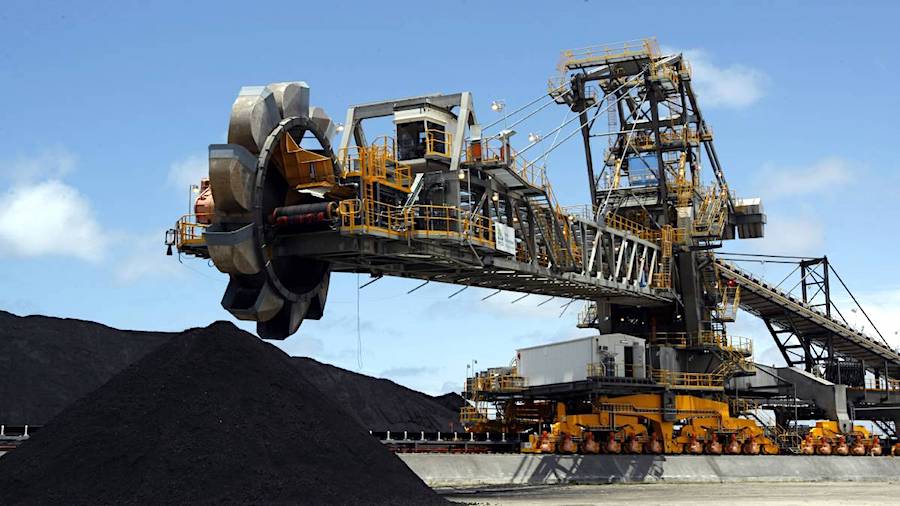Australian coal exports to China slump, but prices are mixed

(The opinions expressed here are those of the author, Clyde Russell, a columnist for Reuters.)
China’s unofficial ban on coal imports from Australia is starting to take its toll on volumes, with departing cargoes down sharply so far in November. But something odd is happening with prices.
China imports two main types of coal from Australia, coking coal used to make steel and thermal coal, used predominantly to generate power, but which can also be used in industrial processes such as cement and ceramics.
As you may expect, the lower Chinese demand for coking coal has hit prices, with Singapore Exchange futures SCAFc1, which mirror free-on-board Australian prices, dropping to a four-year low of $104.86 a tonne on Friday.
Australia has managed to find other customers for the coal that China is not taking
This is down 25.1% from the recent peak of $140 a tonne on Oct. 5, hit just before reports started emerging of Chinese officials giving unofficial verbal instructions to traders and steel mills to halt purchases of Australian coal.
While Beijing has made no official comment on banning Australian coal imports, along with commodities such as copper ores, lobsters and barley, China has made clear its anger over Canberra’s call for an international probe of the origins and early response to the coronavirus pandemic.
Unlike coking coal, however, the price of benchmark Australian thermal coal at the main port of Newcastle has been moving in the opposite direction.
Newcastle coal futures traded on the ICE Exchange NCFMc1 closed at $63.25 a tonne on Friday, down slightly from the prior day’s close of $62.30, which was the highest in seven months.
The contract has gained 30.4% since this year’s low of $48.50 on Sept. 7, and has also rallied about 7% since the start of November.
The Newcastle weekly index ARGMCCINDX=ARG, as assessed by commodity price reporting agency Argus, ended last week at $58.30 a tonne, also the highest since mid-April and about 26% above this year’s low of $46.37 from the first week in September.
The question is why the price of Australian thermal coal should be rising amid an effective ban by China, especially since volumes appear to be plummeting.
Australia’s exports of both coking and thermal coal to China were 3.35 million tonnes in October, up slightly from September’s 3.31 million, but dramatically down from 12.33 million in June, the strongest month so far this year, according to vessel-tracking data compiled by Refinitiv.
The sharp drop in recent months appears likely to get worse in the current month, with just four vessels having loaded coal until now with China as a destination.
While the data only reflects the first half of November, it is worth noting that October saw 33 ships depart Australia for China, and the peak month of June saw 124 departures.
Australia surviving without China?
However, the shipping data also shows that Australia’s total exports have not been too badly affected, with October departures of 29.34 million tonnes only slightly below September’s 29.86 million and the 32.7 million from the peak month this year of June.
This suggests that Australia has managed to find other customers for the coal that China is not taking, and indeed exports to India in the three months to October were the highest since April, with September’s figure of 5.97 million tonnes the highest in Refinitiv data going back to the start of 2015.
However, India’s coal imports from Australia are overwhelmingly coking coal and therefore should have little impact on the price of thermal coal.
Outside China, Australia’s major thermal coal customers are Japan and South Korea, which present a more positive picture for Australian coal miners.
Australia’s exports to Japan have picked up slightly in recent months, with October’s 8.3 million tonnes and September’s 8.45 million being the best since March.
Shipments to South Korea were 4.95 million tonnes in October, up from 4.24 million in September and the strongest since December last year.
Another factor is that China is having to scramble to source alternative supplies of thermal coal, and there are few countries that can easily step up and deliver coal of the same quality as Australia.
One of those is South Africa, where the price of thermal coal at the main export port of Richards Bay API4INDEX=ARG, has been rallying, ending at $67.09 a tonne for the week to Friday, up 17.5% from a recent low in mid-October.
The rising price of alternatives to Australia’s Newcastle has the effect of dragging up the price there as well, notwithstanding Chinese buyers’ withdrawal from the Australian market.
It is also likely that some global trading players have taken bullish positions in anticipation of Chinese traders trying to find alternatives to Australian cargoes.
Overall, what appears to be happening is that the thermal coal market is adjusting to the increased likelihood that China will buy less from Australia, and more from elsewhere, even if it ends up in higher prices for a period.
(Editing by Clarence Fernandez)
More News
{{ commodity.name }}
{{ post.title }}
{{ post.date }}

Comments